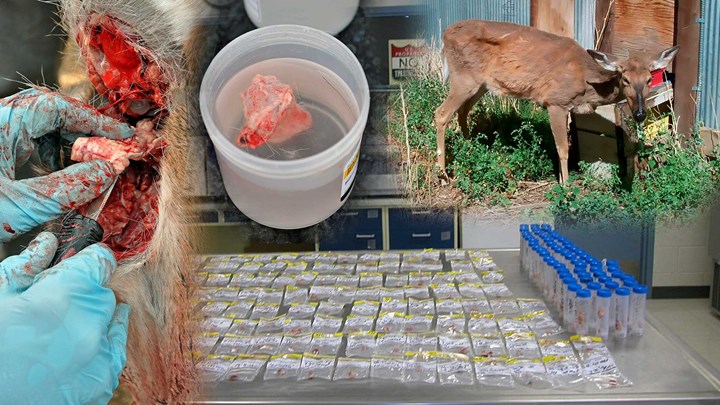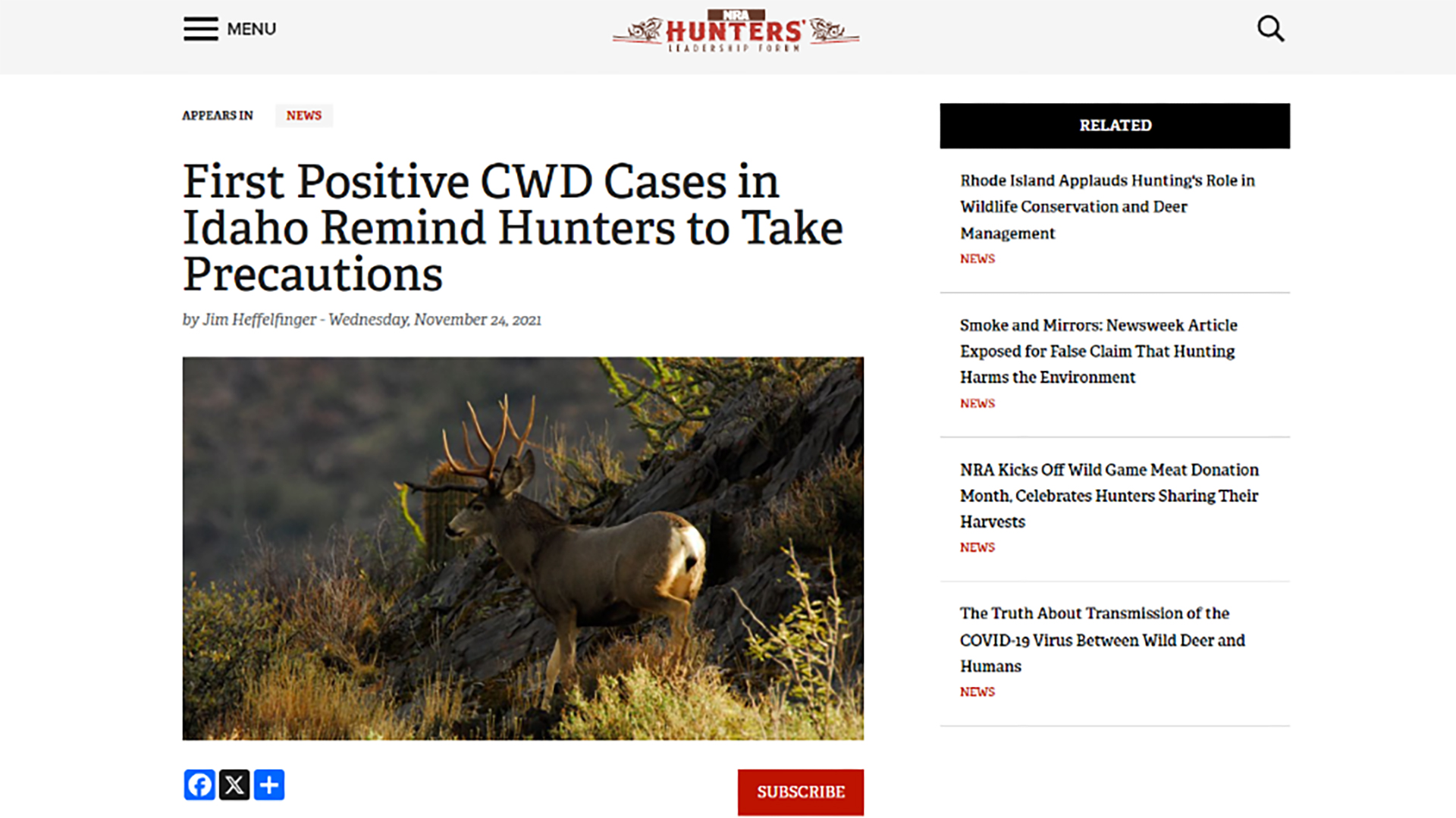
by Jim Heffelfinger - Monday, September 16, 2024

When an adult white-tailed doe north of Spokane, Wash., recently tested positive for chronic wasting disease (CWD), everyone tried to act surprised. The reality was that after deer started turning up positive for CWD right across the border in Idaho in 2021, it was only a matter of time before Washington joined the growing membership in the CWD Club. The deer was found dead in Washington last February and the appropriate samples were collected but held until they had enough samples to submit to the lab in a batch. In July, the Animal Disease Laboratory at Washington State University reported that the doe was positive for infectious prions, the misshapen protein that causes CWD.

This deer died in the Fairwood area in Game Management Unit (GMU) 124, which is 160 miles from the original detection in Idaho but only 70 miles from a new CWD-positive deer in the Idaho panhandle this summer. The expected nature of the first Washington CWD-positive deer is because the insidious spread of the disease made it almost inevitable that a positive deer would show up in adjacent areas, including Spokane County, Washington, with 55 miles of its eastern boundary pressed against the state of Idaho. In fact, the new Washington CWD detection is a mere 17 miles from Idaho.
Unfortunately, CWD needs no introduction by now. This always-fatal disease with no cure is not going away; it keeps spreading to new areas and increasing in prevalence (percent of the population infected). This disease infects members of the deer family (called “cervids”), which for the state of Washington means mule deer, black-tailed deer, white-tailed deer, elk and moose. Washington is also home to two federally protected species that are vulnerable to CWD, the woodland caribou and Columbian white-tailed deer, managed in partnership with the U.S. Fish and Wildlife Service.
Including Washington, there are now 35 states and four Canadian provinces in the CWD Club. Wildlife health professionals generally suspect at this point that if a state has not documented CWD yet, it is because they simply have not detected it yet. Still, this doesn’t mean agencies responsible for managing these herds should just throw up their hands and accept their fate. That would not be responsible because this disease has the potential to seriously impact the deer populations on which we all rely. Because infected deer live an average of two years, CWD can reduce deer populations when the prevalence rate is high enough. If more than half the bucks in the population become infected, you can’t expect to maintain an older age structure with lots of mature bucks.
Doing nothing is not the answer, but controlling and managing CWD is very difficult. Scientists believe the infectious proteins (prions) spread from deer to deer via body fluids like saliva, blood, urine or feces. Infection of deer can be from direct contact at a bait pile or salt lick, or indirectly through prions in contaminated soil, food or water. Since it is not possible to test for it reliably in live deer, it requires the extraction of lymph nodes or brain tissue from dead deer. Tests designed for live animals are not sensitive enough to detect a positive animal with a high degree of certainty so this complicates the management of the disease at the population level in captivity and the wild.
States with no CWD detections yet are working very hard to keep it out. Once in a state, there are intuitive ways to slow the spread and keep prevalence low, including by following these precautions: (1) don’t congregate deer; (2) don’t move deer; (3) keep fewer bucks in the population since they have twice the CWD prevalence rate; (4) maintain a younger buck age structure since mature bucks are more likely to be positive; and (5) manage for fewer deer on the landscape (lower deer densities). If CWD is detected for the first time in a state, and it exists in one small area, then eradication might work. Increased and targeted harvest in that area certainly will give you more info on prevalence and distribution. After it is established in a state for a while, eradication through harvest is not going to be effective. Many of these management options to curb CWD spread and prevalence are not popular with those of us who cherish deer hunting with family and friends and value all of the great meals that deer provide. However, if we don’t do all we can to keep this disease at a low level and local, we will see irreversible damage to important deer and elk herds.
Washington has been testing for CWD since 1995 but stepped up its efforts in 2021 in the eastern part of the state because of the proximity to known cases in western Montana and Idaho. Once it is detected in a state, then a CWD plan is implemented. All states have plans they are implementing or waiting to implement upon detection. Washington had a plan, finalized in 2021, waiting for this recent detection. The Washington State CWD Management Plan has four objectives related to: (1) communication and outreach, (2-3) keeping CWD out of the state and establishing a robust surveillance program; and (4) minimizing potential for long-term effects on members of the deer family. When CWD was detected this year, the Washington Department of Fish and Wildlife immediately updated its plan to incorporate the information learned by other states dealing with CWD. Most of what was updated was Chapter 5 of the plan that describes the initial emergency response to a CWD detection.
The primary objective in Washington is to contain CWD in the immediate area of detection through a series of actions designed to work together and contribute to that objective:
1. Establish a Transport Restriction Zone encompassing Region 1 (100 series GMUs). This is a large enough area to provide reasonable access to taxidermists, meat processors and carcass disposal without leaving the area. The only deer parts that can be transported out of the zone are: boned out meat; skulls or antlers or teeth without any soft tissue or velvet; hides and capes without heads; tissue for diagnosis and testing, and finished taxidermy mounts.
2. Conduct intensive sampling and testing around the detection location. If you harvest or salvage a deer, elk or moose in GMUs 124, 127 or 130, you are required to submit the whole head with at least three inches of neck attached, or extracted lymph nodes, within three days.
3. Prohibit rehabilitation or transportation of live cervids into or out of the zone.
4. Identify department-approved landfills for proper carcass disposal.
5. Remove artificial concentrations of deer: Baiting is now illegal in GMUs 124, 127 and 130.
6. Reduce deer density.
7. Adjust permit numbers and seasons dates that will help increase harvest and get more samples.
There is no evidence of CWD infecting people despite erroneous headlines that show up periodically and spread like a destructive wildfire that must be put out by knowledgeable health professionals. Chronic Wasting Disease was first detected in wild deer in 1981 and tens of thousands of people have been eating CWD-positive deer and elk for more than four decades with no human cases of CWD and no increased prevalence of related human diseases like Creutzfeldt-Jakob disease (CJD). There seems to be a good barrier between the deer family and humans based on studies, but the Center for Disease Control and Prevention (CDC) still recommends you don’t eat meat from deer testing positive for CWD. This is not surprising from an agency with that name. Its concern is that eating CWD-positive deer just increases the risk of someone proving that there is an exception to every rule.
Whether you eat meat from animals testing positive or not is a personal decision that everyone has to make themselves based on reliable information. It also probably has something to do with how much venison you have in your freezer at the time. Regardless, all hunters should be testing all their deer in areas where the management agency is doing surveillance for this disease. Professionals have to be able to make herd management decisions based on the best data available and that requires cooperation from the hunting community. Also, know and follow all the laws on carcass handling and transportation in the area you hunt and live. Washington is the latest member of the CWD club, but it likely will not be the last to join. We all need to do our part to keep it out, keep it low and keep it local.
About the Author
A wildlife biologist with degrees from the University of Wisconsin-Stevens Point and Texas A&M University-Kingsville, Jim Heffelfinger has worked for state and federal wildlife agencies and universities and in the private sector. He is the author of Deer of the Southwest and the author or co-author of more than 200 magazine articles, 50 scientific papers, 20 book chapters and numerous outdoor TV scripts. Chairman of the Western Association of Fish and Wildlife Agencies’ Mule Deer Working Group, representing 24 Western states and Canadian provinces, he also is the recipient of the Wallmo Award, presented to the leading mule deer biologist in North America, and was named the Mule Deer Foundation’s 2009 Professional of the Year. A member of the International Defensive Pistol Association and the U.S. Practical Shooting Association, Heffelfinger enjoys weekly competitions with his 1911. The opinions expressed here are his own and reflect his personal point of view.
E-mail your comments/questions about this site to:
[email protected]
Proudly supported by The NRA Foundation and Friends of NRA fundraising.
